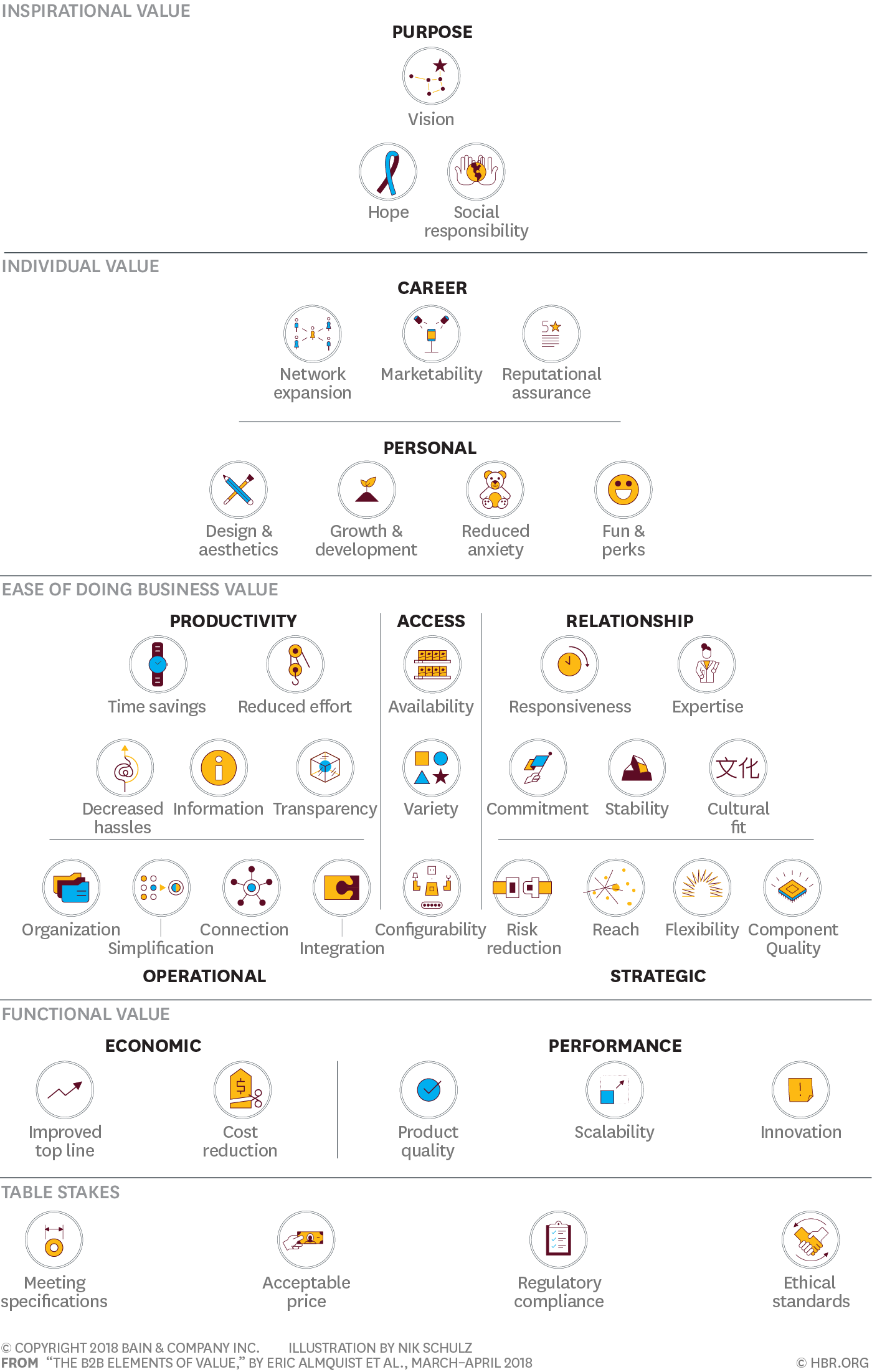How do customers want to be served?
As a result of three decades of consumer research and observation for corporate clients, the authors – all at Bain & Company – identified the “elements of value.” B2C and B2B customers’ purchasing decisions are guided by Bain’s Elements of Value.
Insights explore how companies can move beyond price to offer more value.
Every product has its own value, which is determined by the individual.
There are, however, universal building blocks of value.
Leaders must compare their value offerings with their competitors, close value gaps, and come up with innovative and creative value combinations.
“… When customers evaluate a product or service, they weigh its perceived value against the asking price…”
A hierarchical pyramid, inspired by Maslow’s Hierarchy of Needs, organizes these elements (30 for B2C and 40 for B2B) into basic and aspirational value offerings.
In this pyramid, the elements are arranged according to four types of needs: functional, emotional, life-changing, and social impact.
These elements, according to the authors, can result in stronger customer loyalty, increased consumer willingness to try a particular brand, and sustained revenue growth.
B2B Elements of Value
What do your B2B customers value?
B2B pyramids integrate aspects of negotiation, functionalities, classifications of value to businesses, careers, and people, and purposeful dating.
 |
| Picture: Harvard Business Review |
B2C Elements of Value
There are some great products that serve a very specific purpose.
There are other products that hit on several elements, and this mix is what creates differentiation and loyalty.
 |
| Picture: Harvard Business Review |
By understanding what your customers really value, you can differentiate your offering, grow, gain share, and the price at a premium.
With Elements of Value, you can identify what matters most and deliver it efficiently.
The authors use real-world examples to illustrate how companies have used the elements to grow revenue, refine product design, identify customers’ strengths and weaknesses, and cross-sell products.
You can use the elements of value frameworks in a jobs-to-be-done analysis to think broadly about what matters most to your customers.
Inspirations:
– Harvard Business Review Article
– Elements of Value by Bain & Company
I am incredibly grateful that you have taken the time to read this post.
Support my work by sharing my content with your network using the sharing buttons below.
Want to show your support and appreciation tangibly?
Creating these posts takes time, effort, and lots of coffee—but it’s totally worth it!
If you’d like to show some support and help keep me stay energized for the next one, buying me a virtual coffee is a simple (and friendly!) way to do it.
Do you want to get new content in your Email?
Do you want to check previous Explaining articles? Check these from the last couple of weeks:
- Explaining: The Project Management Institute (PMI)
- Explaining: Personal Branding
- Explaining: The Habit Loop
- Explaining: The Plateau Effect
- Explaining: Rapid Application Development (RAD)
- Explaining: Theory of Constraints (TOC)
- Explaining: Balanced Scorecard (BSC)
- Explaining: Business Model Canvas
- Explaining: Nonviolent Communication
- Explaining: Dynamic Systems Development Method (DSDM)
Check also my latest Book Notes:
- Book Notes #127: The Laws of Simplicity by John Maeda
- Book Notes #126: Inevitable by Mike Colias
- Book Notes #125: Revenge of the Tipping Point by Malcolm Gladwell
- Book Notes #124: Radical Candor by Kim Scott
- Book Notes #123: The Personal MBA by Josh Kaufman
- Book Notes #122: The First 20 Hours by Josh Kaufman
- Book Notes #121: A World Without Email by Cal Newport
- Book Notes #120: Storynomics by Robert McKee and Thomas Gerace
- Book Notes #119: Getting Things Done by David Allen
- Book Notes #118: Supercommunicators by Charles Duhigg
Check my main categories of content below:
- Articles
- Book Notes
- Career Development
- Explaining
- Leadership
- Lean and Agile
- Management
- Personal Development
- Project Management
- Reading Insights
- Technology
Navigate between the many topics covered in this website:
Agile Agile Coaching Agile Transformation Art Artificial Intelligence Blockchain Books Business Business Tales C-Suite Career Coaching Communication Creativity Culture Cybersecurity Decision Making Design DevOps Digital Transformation Economy Emotional Intelligence ESG Feedback Finance Flow Focus Gaming Generative AI Goals GPT Habits Harvard Health History Innovation Kanban Large Language Models Leadership Lean Learning LeSS Machine Learning Magazine Management Marketing McKinsey Mentorship Metaverse Metrics Mindset Minimalism MIT Motivation Negotiation Networking Neuroscience NFT Ownership Paper Parenting Planning PMBOK PMI PMO Politics Portfolio Management Productivity Products Program Management Project Management Psychological Safety Readings Remote Work Risk Management Routines Scrum Self-Improvement Self-Management Sleep Social Media Startups Strategy Team Building Technology Time Management Volunteering Web3 Work
Support my work by sharing my content with your network using the sharing buttons below.
Want to show your support tangibly? A virtual coffee is a small but nice way to show your appreciation and give me the extra energy to keep crafting valuable content! Pay me a coffee:

